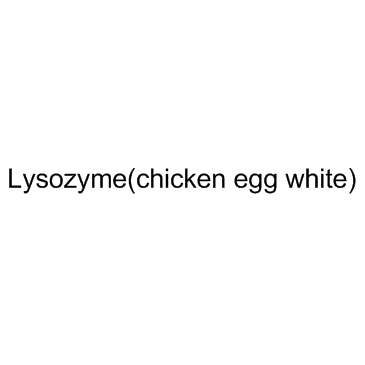Lysozyme

Lysozyme structure
|
Common Name | Lysozyme | ||
|---|---|---|---|---|
| CAS Number | 12650-88-3 | Molecular Weight | 2899.27014 | |
| Density | N/A | Boiling Point | N/A | |
| Molecular Formula | C15H20O4 | Melting Point | N/A | |
| MSDS | USA | Flash Point | N/A | |
Use of LysozymeLysozyme from chicken egg white is a bactericidal enzyme present in chicken eggs, and it lyses gram-positive bacteria. |
| Name | Lysozyme |
|---|---|
| Synonym | More Synonyms |
| Description | Lysozyme from chicken egg white is a bactericidal enzyme present in chicken eggs, and it lyses gram-positive bacteria. |
|---|---|
| Related Catalog | |
| Target |
Bacteria[1] |
| In Vitro | Lysozyme is an ubiquitous enzyme. The hen egg is the most abundant source of lysozyme, which constitutes approximately 3.4% of the albumen proteins. Lysozyme is a natural antimicrobial that hydrolyzes the β(1-4) glycosidic linkage between N-acetylmuramic acid and N-acetylglucosamine found in the peptidoglycan layer of the bacterial cell wall and causing cell lysis. The bactericidal effect of lysozyme is primarily limited to gram-positive bacteria, including pathogens such as Listeria monocytogenes and certain Clostridium species as well as some spoilage organisms, including thermophilic spore-forming bacteria and certain yeasts. The gram-negative bacteria are more resistant to lysozyme action because of their complex cell wall structure[1]. |
| Kinase Assay | For measurement of lytic activity in egg white at each pH, temperature, and CO2 condition, eggs are randomly selected from a flat of eggs (2 dozen eggs) obtained from a local grocery store. To determine the amount of egg white to be added to obtain a 0.001% lysozyme concentration, it is documented that chicken egg white contains approximately 3.4% lysozyme. For determining egg white activity, 0.030 g of albumen was added to 100 mL of the buffered solutions. This equated to a concentration of approximately 0.001% lysozyme. In addition, the egg white contains other antimicrobial proteins that are naturally present, as mentioned in the Introduction section[1]. |
| References |
| Molecular Formula | C15H20O4 |
|---|---|
| Molecular Weight | 2899.27014 |
| Appearance of Characters | powder | white |
| Storage condition | 2-8°C |
| Water Solubility | Soluble in water at 10mg/ml. |
| Personal Protective Equipment | Eyeshields;Gloves;half-mask respirator (US);multi-purpose combination respirator cartridge (US) |
|---|---|
| Hazard Codes | B |
| Safety Phrases | S22;S24/25 |
| RIDADR | NONH for all modes of transport |
| WGK Germany | 3 |
| RTECS | OL5989850 |
|
A yeast display immunoprecipitation method for efficient isolation and characterization of antigens
J. Immunol. Methods 341(1-2) , 117-26, (2009) Yeast antibody display has found a wide variety of applications including antibody affinity maturation, epitope mapping, and library screening. Here we report a yeast display immunoprecipitation (YDIP... |
|
|
Sequential separation of lysozyme, ovomucin, ovotransferrin, and ovalbumin from egg white.
Poult. Sci. 93(4) , 1001-9, (2014) Ovalbumin, ovotransferrin, ovomucin, and lysozyme are a few of the egg white proteins that can be used as functional components. The objective of this study was to develop a simple, sequential separat... |
|
|
Rab8a vesicles regulate Wnt ligand delivery and Paneth cell maturation at the intestinal stem cell niche.
Development 142 , 2147-62, (2015) Communication between stem and niche supporting cells maintains the homeostasis of adult tissues. Wnt signaling is a crucial regulator of the stem cell niche, but the mechanism that governs Wnt ligand... |
| mucopeptide-glycohydrolase |
| muramidase grade iii |
| EINECS 235-747-3 |
| MFCD00131557 |
| mucopeptide n-acetylmuramoylhydrolase |
| muramidase |
| mucopeptide n-acetylmuramoylhydrolase grade vi: chloride |
| reduced lysozyme, water soluble |
| mucopeptide glycolhydrolase |
| mucopeptide n-acetylmuramoylhydrolase grade iii |
| Lysozyme from chicken egg white |

